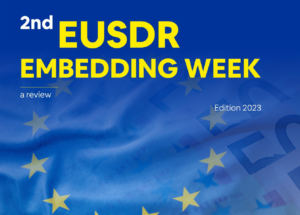If you are a representative of a managing authority / programming authority or an EUSDR National Coordinator / Priority Area Coordinator, seeking to embed the EUSDR into EU programmes for the period 2021 – 2027, this section is for you!
 NEW: 2nd EUSDR Embedding Week – A Review
NEW: 2nd EUSDR Embedding Week – A Review
The 2nd EUSDR Embedding Week, organised by the Danube Strategy Point, took place from 12 to 16 June 2023. On each day, one thematic workshop brought together, among others, EUSDR stakeholders and the programming and managing authorities, to provide a forum for joint dialogue between programmes and the EUSDR on embedding issues, moving from the programming to the implementation phase.
The 2nd EUSDR Embedding Week Review gives an overview of all thematic sessions held and summarises the discussions and findings of all five days of the event, including many useful links for further reads.
© Danube Strategy Point
And if you wish to dig deeper, get to know the six components of the comprehensive EUSDR Embedding Tool, as elaborated by the Danube Strategy Point, right here and how they can help in the Embedding process. For information on the history of the Embedding process, please scroll down.
Please note:
Within the Danube Region Strategy, Embedding was approached by first defining strategic topics, while the discussion and selection of concrete projects is foreseen for the implementing phase. This approach differs from other macro-regional strategies in which Embedding was approached by first defining viable project ideas – as part of the programming phase – and then deriving strategic topics from those project ideas.
History of the Embedding process
Towards a more coordinated approach of MRS key implementers and programme authorities
The preparation process of post-2020 programming offers a unique opportunity to all European Structural and Investment Funds (ESIF) and others such as IPA and NDICI (former ENI) to address territorial challenges in macro-regional strategies (MRS) more strategically. Previous experiences show that a dialogue between authorities responsible for the programming process and key implementers of MRS is needed to make the best use of EU funding sources.
This view is also supported by the 2nd Commission Report on the Implementation of MRS, which emphasises the importance of a dialogue between the programme authorities and key implementers of macro-regional strategies. Practices in the 2014-2020 programming and implementation period have shown that a better coordination may require going beyond traditional administrative boundaries, and the will from different levels of government to co-operate and co-ordinate actions in order to achieve shared goals and strengthen complementarities and synergies between different instruments.
Embedding EUSDR into EU funding programmes
Following these insights, in November 2019 the Croatian EUSDR Presidency with support of the Danube Strategy Point formulated a Guidance Paper on embedding the Danube Strategy into EU programmes. With the support of EUSDR National Coordinators, the Danube Strategy Point and the Interact programme the Croatian EUSDR Presidency established a Task Force to draft a comprehensive tool, which aims at coordinating the implementation of the EUSDR Action Plan with the EU’s priorities as well as the priorities of the involved pre-accession and neighbouring countries for the next financing period 2021 – 2027. In this regard, IPA funds are relevant for EU pre-accession countries (Bosnia & Herzegovina, Montenegro and Serbia) and NDICI funds are relevant for EU neighbouring countries (Moldova and Ukraine).
In the course of the first two meetings of the EUSDR Task Force Embedding in January and February 2020, it became clear that the revised EUSDR Action Plan (with all its 85 actions) would be hard to utilize in the embedding process. Therefore, in April 2020 Priority Area Coordinators and their Steering Groups were asked to compile a shortlist of up to three strategic topics per PA, based on the EUSDR Action Plan, to be included in the relevant national/regional operational programmes. In doing so, emphasis was placed on the following criteria, resulting in the above-described embedding tool:
- eligibility for ESI, IPA and NDICI funds;
- relevance for as many EUSDR participating states as possible;
- viable links to Annexes D of the European Semester Country Reports 2019 and 2020 and the Implementation Reports from non-EU countries;
- and the European Green Deal which entails the Just Transition Fund.
Until end of July 2020, National Coordinators (NCs) and core decision makers of the Strategy are screening the suggested strategic topics for their feasibility and suitability with regards to embedding on the national level in consultation with the respective Programming/Managing Authorities.
The EUSDR embedding tool, including the shortlist, is a rolling document, which is regularly updated throughout all phases of the embedding process. The tool will be finalised and adapted once the negotiations among EC, EP and Council have ended and the EU Cohesion Policy regulation has been released. For the time being), the tool is available at the Danube Strategy Point upon request. With the definition of strategic topics for embedding, followed by the endorsement of EUSDR member states, the preparation process for embedding ends. Following this phase and as part of the implementing phase, EUSDR stakeholders will soon move on to discuss potential projects addressing the selected strategic topics.
Embedding high on the agenda of all macro-regional strategies
In the second meeting of Chairpersons of the National Coordinators groups (Trio Presidencies) of EU macro-regional strategies and the European Commission on 17th May 2020, representatives of all four MRS updated each other on the proceedings of the embedding process in their respective strategy. Overall, National Coordinators of all four MRS expressed the necessity for an active dialogue with programming authorities to ensure the recognition of MRS priorities / actions in the operational programmes. DG REGIO closely follows the embedding process in all MRS and is committed to the process of ensuring the inclusion of MRS priorities in operational programmes.
Previous Embedding efforts for the programming period 2014 – 2020
Already at the EUSDR National Coordinators meeting in Brussels in December 2015 the National Coordinators (NCs) were invited to provide practical examples of how they aim at ensuring financing of EUSDR relevant projects in their respective countries. The following main findings were drawn from the information provided to DG REGIO:
- At the strategic document level, the EUSDR objectives were generally well embedded in the Partnership Agreements and Operational Programmes texts in the member states. Therefore, this level is not further considered in the following country-specific examples.
- At the operational level, a few countries already applied specific selection criteria in some of their programmes (i.e. giving bonus points, earmarked budget, etc.).
- Regarding internal coordination, many countries already used different approaches which in general seemed suitable for involving the programmes into the process.
- NCs in principle had a good overview of both national and international funding sources at the time.
- Several NCs were taking part in the Monitoring Committee meetings of ESI Funds as member or as observer in order to help facilitate funding of relevant projects.
- The involvement of Steering Group members of the specific Priority Areas at national level in the work of ESIF programmes (i.e. in the work of the Monitoring Committees etc.) via NCs or directly brought tangible results in the implementation, while increasing ownership. Steering Group members were prompted to be active in identifying the funding sources and in describing the added value of the projects to the Managing Authorities (MA) in their respective countries (there were many cases in which there were no links, even if the SG member worked in the same institution where the MA was located).
- Already in 2016 NCs saw the need of Managing Authorities to be involved in the identification of priority projects order to minimise the risk of developing projects not suitable for the identified programmes.
- There was a misunderstanding by some programmes claiming that EUSDR relevance is connected to the proximity of the river. However, the Danube Region is not only the region close by the river. It is the whole region covered by the Interreg Danube Transnational Programme.
DG REGIO expressed its readiness to facilitate further practical arrangements in the countries (e.g. taking part at coordination meetings, in liaising with geographic desks, bringing EC- Delegations on board, etc.). Countries were encouraged to have bilateral consultations with each other in order to get further inspirations or practical hints.
Below reports on the state-of-play of aligning the EUSDR with ESI Funds were provided by the National Coordinators and they reflect the status quo as of January 2016.
Attachments:

